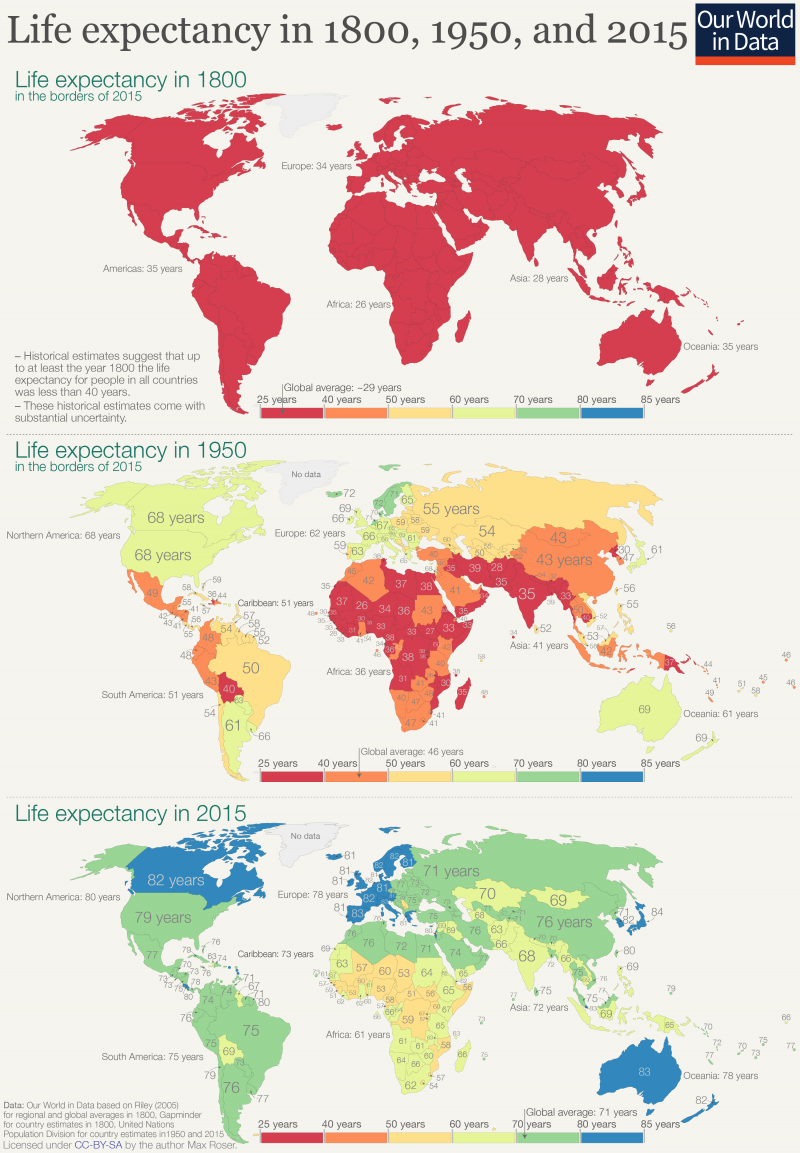The three maps show the global history of life expectancy over the last two centuries.1
Demographic research suggests that at the beginning of the 19th century no country in the world had a life expectancy longer than 40 years.2 Every country is shown in red. Almost everyone in the world lived in extreme poverty, we had very little medical knowledge, and in all countries our ancestors had to prepare for an early death.
Over the next 150 years some parts of the world achieved substantial health improvements. A global divide opened. In 1950 the life expectancy for newborns was already over 60 years in Europe, North America, Oceania, Japan and parts of South America. But elsewhere a newborn could only expect to live around 30 years. The global inequality in health was enormous in 1950: People in Norway had a life expectancy of 72 years, whilst in Mali this was 26 years. Africa as a whole had an average life expectancy of only 36 years, while people in other world regions could expect to live more than twice as long.
The decline of child mortality was important for the increase of life expectancy, but as we explain in our entry on life expectancy increasing life expectancy was certainly not only about falling child mortality – life expectancy increased at all ages.
Such improvements in life expectancy — despite being exclusive to particular countries — was a landmark sign of progress. It was the first time in human history that we achieved sustained improvements in health for entire populations.3 After millennia of stagnation in terrible health conditions the seal was finally broken.
Now, let’s look at the change since 1950. Many of us have not updated our world view. We still tend to think of the world as divided as it was in 1950. But in health — and many other aspects — the world has made rapid progress. Today most people in the world can expect to live as long as those in the very richest countries in 1950. The United Nations estimate a global average life expectancy of 72.6 years for 2019 – the global average today is higher than in any country back in 1950. According to the UN estimates the country with the best health in 1950 was Norway with a life expectancy of 72.3 years.
The three maps summarize the global history of life expectancy over the last two centuries: Back in 1800 a newborn baby could only expect a short life, no matter where in the world it was born. In 1950 newborns had the chance of a longer life if they were lucky enough to be born in the right place. In recent decades all regions of the world made very substantial progress, and it were those regions that were worst-off in 1950 that achieved the biggest progress since then. The divided world of 1950 has been narrowing.
Globally the life expectancy increased from less than 30 years to over 72 years; after two centuries of progress we can expect to live much more than twice as long as our ancestors. And this progress was not achieved in a few places. In every world region people today can expect to live more than twice as long.
The global inequalities in health that we see today also show that we can do much better. The almost unbelievable progress the entire world has achieved over the last two centuries should be encouragement enough for us to realize what is possible.
Life expectancy in 1800, 1950, and 20154


